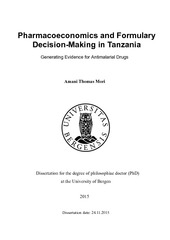| dc.contributor.author | Mori, Amani Thomas | en_US |
| dc.date.accessioned | 2016-03-03T10:45:03Z | |
| dc.date.available | 2016-03-03T10:45:03Z | |
| dc.date.issued | 2015-11-24 | |
| dc.identifier.isbn | 978-82-308-3442-8 | en_US |
| dc.identifier.uri | https://hdl.handle.net/1956/11426 | |
| dc.description.abstract | Introduction: Increasing expenditure on pharmaceuticals has prompted many authorities, mostly in high-income countries, to deploy pharmacoeconomic analysis as a tool to guide formulary decision-making. However, the role of pharmacoeconomics in low-income countries is less well known, notwithstanding an extreme scarcity of healthcare resources. This study aims to assess the role of pharmacoeconomics in formulary decision-making and to generate economic evidence for anti-malarial drugs in Tanzania. Methods: The thesis consists of four sub-studies, which were conducted using four different methodologies. Paper I is a systematic review study which describes the status of pharmacoeconomic analysis studies and their influence in formulary decision-making processes. Paper II is a qualitative case study about national formulary decision-making processes, the criteria used, and the underlying sources of evidence. Data was collected via in-depth interviews with key informants and document reviews and the analysis was done thematically. Paper III uses a Markov decision-model to compare the cost-effectiveness of dihydroartemisinin-piperaquine (DhP) and artemether-lumefantrine (AL) for the treatment of uncomplicated malaria in children, from the provider's perspective. Cost data was collected at a public district hospital located in an urban HIV/AIDS, malaria and diarrhoeal diseases. Only one of these studies was found to have informed the formulary decision-making process; there was no evidence to suggest the remaining studies had any influence on formulary decisions. Decisions to authorize the listing of new drugs in the national formulary are made by committees of experts which often use discretionary judgement and anecdotal evidence, mostly about efficacy and safety, to guide decision-making processes. For diseases of national priority, such as malaria and HIV/AIDS, decisions are usually influenced by WHO recommendations. Limited understanding of the concept of pharmacoeconomic analysis among expert committee members is among the key impediments to its consistent application in national formulary decision-making. The study also found that DhP is more cost-effective than AL when it is used as the first-line drug to treat uncomplicated malaria in children, with an incremental cost-effectiveness ratio (ICER) of US Dollars 12.40 per Disability Adjusted Life Year (DALY) averted. It further predicted that the current treatment policy for malaria, which uses DhP as the second-line drug (AL+DhP), will save about US Dollars 66,800 per year, while achieving a 3% (248,437) reduction in the number of malaria cases, compared to a reference policy of AL+quinine. However, if this policy is replaced with the one which uses DhP as the first-line drug (DhP+AL), it will consume an additional US Dollars 737,800 per year, while achieving a further 5% (364,517) reduction in the number of malaria cases in children. Conclusions: Pharmacoeconomic analysis has a limited role in formulary decision-making in Tanzania. The current situation in the country, which is characterized by an increasing trend in pharmaceutical expenditure on the one hand and limited healthcare budgets on the other, warrants a more consistent application of pharmacoeconomic analysis to guide resource allocation decisions. This study has also generated new pharmacoeconomic evidence which may support the adoption of dihydroartemisinin-piperaquine as the first-line drug to treat uncomplicated malaria in children in Tanzania. | en_US |
| dc.language.iso | eng | eng |
| dc.publisher | The University of Bergen | eng |
| dc.relation.haspart | Paper I: Mori AT and Robberstad B: Pharmacoeconomics and its implication on priority-setting for essential medicines in Tanzania: a systematic review. BMC Medical Informatics and Decision-Making 2012, 12(1): 110. The article is available at: <a href="http://hdl.handle.net/1956/6618" target="blank">http://hdl.handle.net/1956/6618</a> | en_US |
| dc.relation.haspart | Paper II: Mori AT, Kaale EA, Ngalesoni F, Norheim OF, Robberstad B: The role of evidence in the decision-making process of selecting essential medicines in developing countries: The case of Tanzania. PloS ONE, 2014, 9(1): e84824. The article is available at: <a href="http://hdl.handle.net/1956/9679" target="blank">http://hdl.handle.net/1956/9679</a> | en_US |
| dc.relation.haspart | Paper III: Mori AT, Ngalesoni F, Norheim OF, Robberstad B: Cost-effectiveness of dihydroartemisinin-piperaquine compared with artemether-lumefantrine for treating uncomplicated malaria in children at a district hospital in Tanzania. Malaria Journal 2014, 13: 363. The article is available at: <a href="http://hdl.handle.net/1956/8615" target="blank">http://hdl.handle.net/1956/8615</a> | en_US |
| dc.relation.haspart | Paper IV: Mori AT, Norheim OF, Robberstad B: Budget impact analysis of using dihydroartemisinin-piperaquine to treat uncomplicated malaria in children in Tanzania. PharmacoEconomics 2016, 34(3): 303-314. The article is available at: <a href="http://hdl.handle.net/1956/11425" target="blank">http://hdl.handle.net/1956/11425</a> | en_US |
| dc.title | Pharmacoeconomics and Formulary Decision-Making in Tanzania. Generating Evidence for Antimalarial Drugs | en_US |
| dc.type | Doctoral thesis | |
| dc.rights.holder | Copyright the author. All rights reserved | |
| dc.identifier.cristin | 1288829 | |
